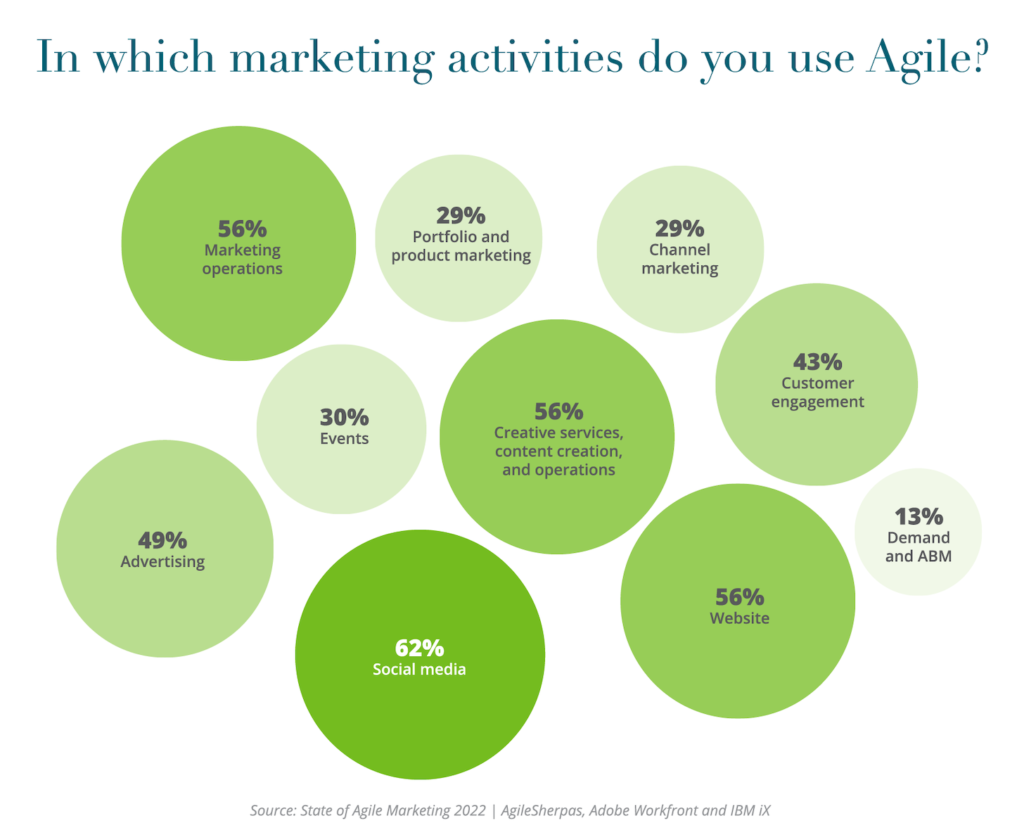“What the heck is this agile marketing thing people keep talking about?!”
If that question is on your mind — and you aren’t familiar with agile software development, from which its ideas sprang — this 5 minute video will give you the quick lowdown. It was recorded at the ASAE’s technology conference earlier this month in an “ignite talk” format — 20 slides, 15 seconds per slide auto-advancing, 5 minutes total. (I’m not sure who was more tired at the end — me or the cameraman.)
For those of you who prefer reading to watching — or if you’re a search engine crawler — here’s an essay version of the talk. Not quite a transcript, but close enough:
In the next 5 minutes, I will share with you the basics of what agile marketing is and why it’s become such a hot topic.
Now “agile” isn’t just an adjective — meaning fast, nimble. Everybody’s agile today, right? But Agile is actually a well-defined management methodology, which got started in software development circles about 15 years ago.
See, software development used to be managed by something called “the waterfall method.” It was called that because projects would be run as a fixed sequence of well-defined stages. You’d start with requirements gathering, then move to design, then implement, test, and deploy.
The diagram looks like a waterfall. And like a waterfall, once you slipped from one step to another, there was no going back. Or let’s just say that swimming back upstream was arduous and full of peril. But the problem is that often people do want to go back.
On paper, the waterfall is neat and organized. But in the real world, things change. Priorities shift. Markets evolve. With software, people often don’t know exactly what they want until they see it.
So a bunch of software developers got together at the turn of the century and forged a better vision for how to run software projects: the manifesto for agile software development. You can read it online. The gist was to take that big, rigid waterfall process and make it more iterative and responsive to change.
There are different variants of agile methodologies. One popular one is known as Scrum. It revolves around small, cross-functional teams of typically no more than eight people — what Jeff Bezos calls a “two pizza team.”
Scrum teams operate on project intervals of 1-4 weeks known as sprints. Bigger projects get broken down into sprint-sized chunks — and each sprint has a functional deliverable. You build something people can use, get feedback on it, and then iteratively improve it in subsequent sprints.
A Scrum team works with a set of user stories — things people want — and a set of tasks to implement those stories. The tasks get prioritized on a backlog on task board. Team members take tasks off the backlog, move them into work-in-progress column, and then move them to done when complete. Everyone can always see the current state of the project just by looking at the task board.
You can use post-it notes for your task board, or you can use software. What matters is that tasks are clear, bite-sized pieces of work, stacked in priority. And an individual always owns a task when it’s in progress.
Another key aspect of Scrum is the daily stand-up. Everyone on the team gets together once a day for a 15-minute huddle. It’s done standing up to remind people keep this meeting strictly to 15 minutes.
At the stand-up, you go around and everyone on the team answers three questions:
- What did I do yesterday?
- What am I going to do today?
- Are there any impediments in my way?
It’s all about continuous progress and transparency.
At the end of a sprint, there are longer sit-down meetings where people review what was accomplished — the sprint review — and reflect on process improvements, in what’s called a sprint retrospective. There’s then a planning meeting for arranging the priorities for the next sprint.
This cycle then repeats. Every sprint, further incremental improvements are delivered — smoothly adapting to feedback and change.
If you haven’t read the book The Lean Start-Up yet, I’d highly recommend it. It argues than any organization — not just start-ups — can harness these build-measure-learn feedback loops. Because here’s the thing: agile isn’t limited it software development. It can also be a great way to run key functions of marketing.
Marketing plans used to look a lot like the waterfall process as well. But as anyone in marketing will tell you, today’s environment requires much greater adaptability and responsiveness. Social media alone is a terrific example of this, where problems and opportunities arise in a matter of hours.
Many of the projects that marketers work on today actually share similarities with software development. For instance, building web sites and landing pages, or producing and distributing content marketing. Marketing campaigns are a kind of project.
Agile marketing can make you more effective in the modern world. It’s a management approach for our time. It puts measurable customer experiences at the center of its vision, and it thrives on the ability to respond to change.
I hope this has given you enough of a taste for agile marketing that you’ll take a closer look. Here are several resources you can follow when you get a copy of this deck. Or just Google “agile marketing” and you’ll be on your way.


